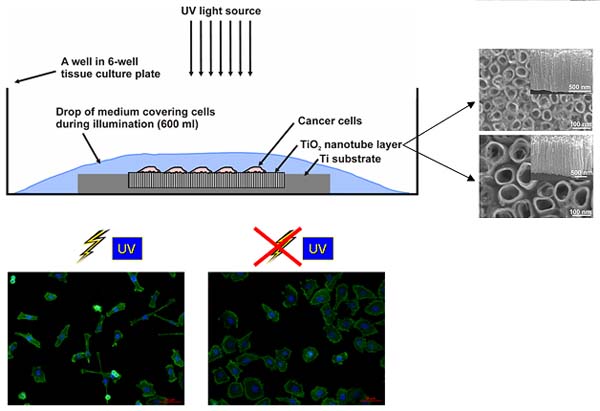Fotodynamická terapie nádorů
The use of TiO2 as a photocatalyst that is able to destroy unwanted and harmful organic compounds in contaminated air or water has been extensively studied since the 1972. In 1985, Matsunaga et al. showed for the first time the ability of UV-irradiated platinized TiO2 nanopowder to kill bacterial cells in an aqueous environment. In 1999, an approach for synthesis of highly ordered, vertically oriented TiO2 nanotubes on Ti and Ti-alloy substrates has been firstly reported by Zwilling et al. Thus, there is only short step to use the vertically aligned TiO2 nanotubes for specific cell killing after the UV-irradiation.
We study the feasibility to use the nanotube surface for enhanced photo-induced cancer cell killing via the action of photocatalytically generated reactive oxygen species (ROS). For this purpose nanotube layers with different average tube diameters (e.g. 50 or 100 nm) are formed, on which HeLa G cancer cells are plated and incubated. After UV exposure the changes in the cell morphology and viability are determined.
It was demonstrated that TiO2 nanotube layers can be used as a photocatalyst for killing of cancer cells. The dimensions of the nanotubes play a role for cell adhesion and spreading. A possible application of the nanotubes may be an anticancer treatment, where isolated tubes are administrated to a tumor, followed by a focused UV-light exposition of the tumor.
More information
Kalbacova M., Macak J.M., Schmidt-Stein, F., Mierke, C. T., Fabry, B., Schmuki, P.: TiO2 nanotubes: Photocatalyst for cancer cell killing: Physica Status Solidi - Rappid Research Letters 2(4): 194-196, 2008

